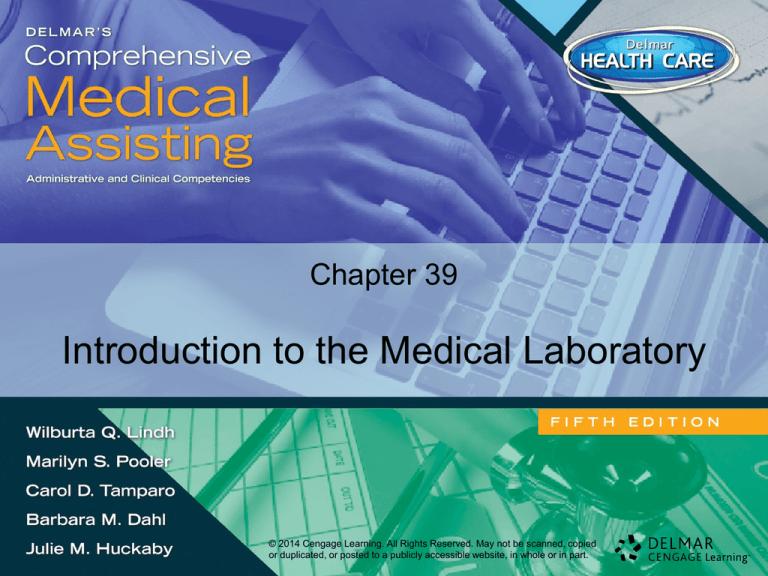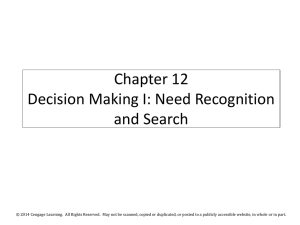
Chapter 39
Introduction to the Medical Laboratory
© 2014 Cengage©Learning.
2014 Cengage
All Rights
Learning.
Reserved.
All Rights
May not
Reserved.
be scanned,
May not
copied
be scanned, copied
or duplicated, or or
posted
duplicated,
to a publicly
or posted
accessible
to a publicly
website,
accessible
in wholewebsite,
or in part.
in whole or in part.
The Laboratory
• Physician’s office laboratory (POL)
obtains and tests specimens
• Specimen obtained at POL and
transported to separate lab for testing
• Collected and tested at separate lab
© 2014 Cengage Learning. All Rights Reserved. May not be scanned, copied
or duplicated, or posted to a publicly accessible website, in whole or in part.
The Laboratory
• Purposes of lab testing
– Record individual’s state of health
• Routine physical examination
• Provides baseline values for comparison
– Satisfy employment, insurance, or legal
requirements
• Employment-required drug and alcohol testing
– Research statistics and clinical trials
© 2014 Cengage Learning. All Rights Reserved. May not be scanned, copied
or duplicated, or posted to a publicly accessible website, in whole or in part.
The Laboratory
• Purposes of lab testing
– To detect asymptomatic conditions or diseases
• No symptoms associated with disease process
• Routine screening in another area reveals disorder
– To confirm a clinical diagnosis
• Diagnosis determined through subjective and objective
information
• Tests given to confirm diagnosis
© 2014 Cengage Learning. All Rights Reserved. May not be scanned, copied
or duplicated, or posted to a publicly accessible website, in whole or in part.
The Laboratory
• Purposes of lab testing
– To differentiate between two or more diseases
• Perform simplest and least invasive test
• Rule out a disease (differential diagnosis)
– To diagnose
• If symptoms are vague
• Panel, or group of related tests
• Helps narrow field for diagnosis
© 2014 Cengage Learning. All Rights Reserved. May not be scanned, copied
or duplicated, or posted to a publicly accessible website, in whole or in part.
The Laboratory
• Purposes of lab testing
– To determine the effectiveness of treatments
– To prevent diseases/disorders
– To prevent the exacerbation of diseases
• Patients with chronic conditions
• May need to adjust diet or medication
© 2014 Cengage Learning. All Rights Reserved. May not be scanned, copied
or duplicated, or posted to a publicly accessible website, in whole or in part.
The Laboratory
• Types of laboratories
–
–
–
–
Independent
Satellite
Hospital-based
Reference
© 2014 Cengage Learning. All Rights Reserved. May not be scanned, copied
or duplicated, or posted to a publicly accessible website, in whole or in part.
The Laboratory
• Types of laboratories
– Point-of-care testing (POCT)
• Near-patient testing or bedside testing
• Brings laboratory services directly to patient
• Rapid, accurate results
© 2014 Cengage Learning. All Rights Reserved. May not be scanned, copied
or duplicated, or posted to a publicly accessible website, in whole or in part.
The Laboratory
• Types of laboratories
– POLs
•
•
•
•
Physically set within office
Types of tests commonly performed
Use of self-contained tests
At-home test kits
© 2014 Cengage Learning. All Rights Reserved. May not be scanned, copied
or duplicated, or posted to a publicly accessible website, in whole or in part.
The Laboratory
• Laboratory personnel
–
–
–
–
–
–
Pathologist
Clinical laboratory scientists
Technicians
Clinical laboratory assistants
Phlebotomists
Medical assistants
© 2014 Cengage Learning. All Rights Reserved. May not be scanned, copied
or duplicated, or posted to a publicly accessible website, in whole or in part.
The Laboratory
Laboratory departments
• Hematology
• Urinalysis
• Clinical chemistry
• Immunohematology
• Serology (immunology)
• Toxicology
•
•
•
•
•
DNA
Microbiology
Parasitology
Cytology
Histology
© 2014 Cengage Learning. All Rights Reserved. May not be scanned, copied
or duplicated, or posted to a publicly accessible website, in whole or in part.
The Laboratory
• Panels of laboratory tests
– Tests categorized into related groups
– Formerly called “profiles”
– CMS-approved organ- and disease-oriented
panels
© 2014 Cengage Learning. All Rights Reserved. May not be scanned, copied
or duplicated, or posted to a publicly accessible website, in whole or in part.
Billing for Laboratory Services
• Providers justify lab tests ordered by
using correct diagnosis code
• If provider wants to order a test not
covered by insurance, patient should
sign waiver
• If clinic fails to notify patient, patient
does not pay for test; provider liable for
charges
© 2014 Cengage Learning. All Rights Reserved. May not be scanned, copied
or duplicated, or posted to a publicly accessible website, in whole or in part.
Quality Controls/Assurances
• Control tests
–
–
–
–
Have known value/results
Compare with results of patient’s test
Minimizes human error
Checks reagents/chemicals
• Proficiency testing
– Similar to quality control
© 2014 Cengage Learning. All Rights Reserved. May not be scanned, copied
or duplicated, or posted to a publicly accessible website, in whole or in part.
Quality Controls/Assurances
• Preventive maintenance
– Helps identify potential problems before they
occur
– Manufacturer’s recommended maintenance
• Instrument validations
– Checks calibration and linear range of instruments
and machines
© 2014 Cengage Learning. All Rights Reserved. May not be scanned, copied
or duplicated, or posted to a publicly accessible website, in whole or in part.
Quality Controls/Assurances
• The medical assistant’s role
–
–
–
–
Perform administrative office duties
Prepare patients
Collect specimens
Perform waived tests
© 2014 Cengage Learning. All Rights Reserved. May not be scanned, copied
or duplicated, or posted to a publicly accessible website, in whole or in part.
Quality Controls/Assurances
• The medical assistant’s role
– When patient prepared properly:
• Specimen obtained expertly
• Reagents and equipment in best condition and
calibration
• Test performed by trained professional
• Test results accurate
© 2014 Cengage Learning. All Rights Reserved. May not be scanned, copied
or duplicated, or posted to a publicly accessible website, in whole or in part.
Laboratory Requisitions and Reports
• Written requisition for laboratory work
must be sent to lab with patient or
specimen
– Preprinted
– Computer-generated
© 2014 Cengage Learning. All Rights Reserved. May not be scanned, copied
or duplicated, or posted to a publicly accessible website, in whole or in part.
Laboratory Requisitions and Reports
• Features of requisition
–
–
–
–
–
–
–
Provider’s information
Patient’s name, address, phone numbers
Patient’s billing information
Unique patient identifier
Patient’s age/date of birth and sex
Source of specimen
Time and date of specimen collection
© 2014 Cengage Learning. All Rights Reserved. May not be scanned, copied
or duplicated, or posted to a publicly accessible website, in whole or in part.
Laboratory Requisitions and Reports
• Features of requisition
–
–
–
–
–
–
Test requested
Medications patient is taking
Clinical diagnosis
Urgency of results
Special collection/patient instructions
Other provider(s) to receive copies of report
© 2014 Cengage Learning. All Rights Reserved. May not be scanned, copied
or duplicated, or posted to a publicly accessible website, in whole or in part.
Laboratory Requisitions and Reports
• Features of written lab reports
– Laboratory name, address, and phone numbers
– Referring provider’s name and identification
numbers
– Patient’s name, ID number, age, sex
© 2014 Cengage Learning. All Rights Reserved. May not be scanned, copied
or duplicated, or posted to a publicly accessible website, in whole or in part.
Laboratory Requisitions and Reports
• Features of written lab reports
–
–
–
–
Date specimen was received by laboratory
Date and time specimen was collected
Date laboratory reported results
Test name, results, and normal reference ranges
© 2014 Cengage Learning. All Rights Reserved. May not be scanned, copied
or duplicated, or posted to a publicly accessible website, in whole or in part.
Laboratory Requisitions and Reports
• Attach to patient’s
chart
• Notify provider of
abnormal results
Computerized laboratory
report >>
© 2014 Cengage Learning. All Rights Reserved. May not be scanned, copied
or duplicated, or posted to a publicly accessible website, in whole or in part.
Specimens
• Proper procurement, storage, and
handling
–
–
–
–
–
Obtain from independent laboratories
Instruction manual
Obtain specimen in proper manner
Use right equipment
Guidelines
© 2014 Cengage Learning. All Rights Reserved. May not be scanned, copied
or duplicated, or posted to a publicly accessible website, in whole or in part.
Specimens
© 2014 Cengage Learning. All Rights Reserved. May not be scanned, copied
or duplicated, or posted to a publicly accessible website, in whole or in part.
Specimens
• Processing/sending specimens to lab
– Patient’s insurance often dictates laboratory
contracted
– Often differences between laboratories
– Type of specimen acceptable for one laboratory
not necessarily acceptable specimen for another
© 2014 Cengage Learning. All Rights Reserved. May not be scanned, copied
or duplicated, or posted to a publicly accessible website, in whole or in part.
Microscopes
• One of the most
used pieces of
equipment in
laboratory
• Parts
–
–
–
–
–
Light source
Eyepieces
Objectives
Condenser
Diaphragm
© 2014 Cengage Learning. All Rights Reserved. May not be scanned, copied
or duplicated, or posted to a publicly accessible website, in whole or in part.
Microscopes
• Types of microscopes
–
–
–
–
Compound
Phase contrast
Fluorescent
Electron
© 2014 Cengage Learning. All Rights Reserved. May not be scanned, copied
or duplicated, or posted to a publicly accessible website, in whole or in part.
Microscopes
• How to use a microscope
– Adjusting focus with coarse and fine adjustments
– Raise platform of lower objectives using coarse
adjustment and low-power objective while viewing
slide from side
– Control intensity of light with condenser and iris
diaphragm
– Oil-immersion lens
© 2014 Cengage Learning. All Rights Reserved. May not be scanned, copied
or duplicated, or posted to a publicly accessible website, in whole or in part.
Microscopes
• How to care for a
microscope
Proper way to carry a
microscope >>
© 2014 Cengage Learning. All Rights Reserved. May not be scanned, copied
or duplicated, or posted to a publicly accessible website, in whole or in part.
Microscopes
• How to care for a microscope
– Follow manufacturer’s and clinic’s rules
– Carry with one hand securely supporting base and
other hand holding arm
– Cover microscope when not in use
– Clean lenses with special lens paper after each
use
– Always move platform away from, never toward,
eyepiece
– Use oil only with oil-immersion lens
© 2014 Cengage Learning. All Rights Reserved. May not be scanned, copied
or duplicated, or posted to a publicly accessible website, in whole or in part.








